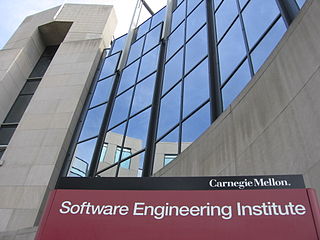
The Software Engineering Institute (SEI) is an American research and development center headquartered in Pittsburgh, Pennsylvania. Its activities cover cybersecurity, software assurance, software engineering and acquisition, and component capabilities critical to the Department of Defense.
In computer engineering, a hardware description language (HDL) is a specialized computer language used to describe the structure and behavior of electronic circuits, and most commonly, digital logic circuits.
In computer science, communicating sequential processes (CSP) is a formal language for describing patterns of interaction in concurrent systems. It is a member of the family of mathematical theories of concurrency known as process algebras, or process calculi, based on message passing via channels. CSP was highly influential in the design of the occam programming language, and also influenced the design of programming languages such as Limbo, RaftLib, Go, Crystal, and Clojure's core.async.

The School of Computer Science (SCS) at Carnegie Mellon University in Pittsburgh, Pennsylvania, US is a leading private school for computer science established in 1988. It has been consistently ranked among the top computer science programs over the decades. U.S. News & World Report currently ranks the graduate program as tied for 1st with Massachusetts Institute of Technology, Stanford University, and University of California, Berkeley.
A modeling language is any artificial language that can be used to express information or knowledge or systems in a structure that is defined by a consistent set of rules. The rules are used for interpretation of the meaning of components in the structure.
Capability Maturity Model Integration (CMMI) is a process level improvement training and appraisal program. Administered by the CMMI Institute, a subsidiary of ISACA, it was developed at Carnegie Mellon University (CMU). It is required by many United States Department of Defense (DoD) and U.S. Government contracts, especially in software development. CMU claims CMMI can be used to guide process improvement across a project, division, or an entire organization. CMMI defines the following maturity levels for processes: Initial, Managed, Defined, Quantitatively Managed, and Optimizing. Version 2.0 was published in 2018. CMMI is registered in the U.S. Patent and Trademark Office by CMU.
The Architecture Analysis & Design Language (AADL) is an architecture description language standardized by SAE. AADL was first developed in the field of avionics, and was known formerly as the Avionics Architecture Description Language.
John Robert Anderson is a Canadian-born American psychologist. He is currently professor of Psychology and Computer Science at Carnegie Mellon University.
A system architecture or systems architecture is the conceptual model that defines the structure, behavior, and more views of a system. An architecture description is a formal description and representation of a system, organized in a way that supports reasoning about the structures and behaviors of the system.
Product-family engineering (PFE), also known as product-line engineering, is a synonym for "domain engineering" created by the Software Engineering Institute, a term coined by James Neighbors in his 1980 dissertation at University of California, Irvine. Software product lines are quite common in our daily lives, but before a product family can be successfully established, an extensive process has to be followed. This process is known as product-family engineering.
CMU Sphinx, also called Sphinx in short, is the general term to describe a group of speech recognition systems developed at Carnegie Mellon University. These include a series of speech recognizers and an acoustic model trainer (SphinxTrain).
Randal E. Bryant is an American computer scientist and academic noted for his research on formally verifying digital hardware and software. Bryant has been a faculty member at Carnegie Mellon University since 1984. He currently teaches course in computer systems with Professor David R. O'Hallaron. He served as the Dean of the School of Computer Science(SCS) at Carnegie Mellon from 2004 to 2014.

The Human-Computer Interaction Institute (HCII) is a department within the School of Computer Science at Carnegie Mellon University (CMU) in Pittsburgh, Pennsylvania. It is considered one of the leading centers of human-computer interaction research, and was named one of the top ten most innovative schools in information technology by Computer World in 2008. For the past three decades, the institute has been the predominant publishing force at leading HCI venues, most notably ACM CHI, where it regularly contributes more than 10% of the papers. Research at the institute aims to understand and create technology that harmonizes with and improves human capabilities by integrating aspects of computer science, design, social science, and learning science.

Mary Shaw is an American software engineer, and the Alan J. Perlis Professor of Computer Science in the School of Computer Science at Carnegie Mellon University, known for her work in the field of software architecture.

Edmund Melson Clarke, Jr. is an American retired computer scientist and academic noted for developing model checking, a method for formally verifying hardware and software designs. He is the FORE Systems Professor of Computer Science Emeritus at Carnegie Mellon University. Clarke, along with E. Allen Emerson and Joseph Sifakis, is a recipient of the 2007 Association for Computing Machinery A.M. Turing Award.

A view model or viewpoints framework in systems engineering, software engineering, and enterprise engineering is a framework which defines a coherent set of views to be used in the construction of a system architecture, software architecture, or enterprise architecture. A view is a representation of a whole system from the perspective of a related set of concerns.
Software architecture description is the set of practices for expressing, communicating and analysing software architectures, and the result of applying such practices through a work product expressing a software architecture.






